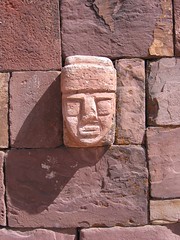Hoja de Coca no es Droga

Coca leaves are not a drug. This is a slogan I saw on t-shirts in La Paz, illustrating a current political issue that causes lots of strife in Bolivia. Coca leaves are used in tea, or chewed by miners and many residents of the Altiplano (the high mountain regions) to ward off cold, hunger, pain, and the effects of altitude. As mood-altering as this might sound, coca is not a drug. However, the coca plant is also used in the production of cocaine, and as a result, many countries, chiefly the U.S., have been pumping millions of dollars into an effort to eradicate the entire coca industry. As this is one of Bolivia´s major industries, understandably this causes some, er, disagreement amongst coca production workers. Not to mention that it creates some anti-American sentiment. So when I heard there was a strike planned, involving closing off all the roads leading out of La Paz and as rumor had it, the little old coca leaf was going to be at the center of it, I decided that a week in La Paz was enough and it was time to go.
So off I went yesterday to Tiwanaku, the site of ancient ruins of a pre-Incan civilization. Yesterday I checked out the town, earning perplexed and/or amused looks from the locals, as I was the only gringo in town. This morning I went off to see the ruins. Well, do I feel ignorant or what? Apparently the Tiwanaku culture lived for nearly 2000 years in this area of the world, and spread their influence to many neighboring cultures. They had lovely pottery, tools, jewelery, an advanced systems of canals and architecture which is still being discovered. Also, they were several millenia ahead of the rest of the world in the trend for lip-piercing. In comparison, the Inca society apparently lasted only 90 years or so! (I´m not sure if you even qualify as a civilization in my book.) When I asked Elias, my guide, why it was the world is largely unaware of the Tiwanaku people and the Incas get all the glory, his answer was that it is all in the marketing, and Bolivia is a poor country, which can´t afford to promote its history on a global scale. Whatever the reason, I was certainly surprised and humbled to learn about this entire culture which had not previously come to my attention.
So anyway, I was pleased with myself for getting ahead of the game and getting out of the city before it got closed off due to strike (a strike which, in the end, apparently had nothing to do with coca production, but which had to do with the nationalization of the gas industry, which is another big topic). Imagine my surprise to find out that all the roads are blocked, including the road to little old Tiwanaku. So the only solution was: I would hitchhike. I walked about a mile and a half to the junction of the highway, avoiding the road-blockers in case they sensed my nationality from a distance and started throwing rocks. I chatted with some Bolivian high-school guys, practicing their trumpets (I sincerely hope they are not planning for a musical career) who gave me a ride to the optimal spot on their bikes. There were loads of people looking for rides, but I was happy to be the only one going in the direction of Peru. After three hours I got picked up by a young Bolivian couple, who brought me to the next town and then asked for payment--turns out they were profiting from the roadblocks by spending their day going back and forth on that stretch of road picking up stranded hitchhikers. But that wasn´t the end of it; I then had to pass through the military checkpoint and wait another hour or so for a taxi to come along, take it to the Peruvian border, walk across the bridge, have my passport stamped (twice, once for leaving Bolivia and once for entering Peru), then get another bus to Puno, where I am now. There was a Mexican guy in the cab, headed the same way, which was nice because I could let him do the talking...Bolivians definitely seem to trust him more than me. By the way, he came from La Paz via a taxi-taxi-bike-taxi combo today, and said that there were actually rioters in the streets and they were actually throwing some kind of explosives. So although that would make an interesting story for the grandkids, I´m glad I got out while it was still fairly calm.
So...that was a long story, and probably involved more of me spending hours sitting alone on the edge of a highway for some people´s tastes, but here I am safe and sound. Not to mention a little perplexed...after all, I didn´t plan to be in Peru today. I´ll spend a day here and then head off to my next destination, back in Bolivia. I´ll leave its name a secret for now, except to tell you that it might make some of you want to sing. Any guesses?
P.S. I uploaded some more photos of La Paz, as well as some of the ruins, including some completely unnecessary ones I took while waiting for a ride. Click on the appropriate links to check them out.












<< Home